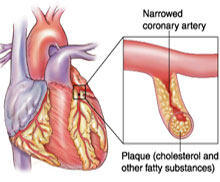Coronary Artery Disease & Heart Valve Disorders
Written By: Adam Pick, Patient Advocate, Author & Website Founder
Page Last Updated: May 11, 2025
Coronary heart disease (CHD) is a name for several maladies of the heart. Some medical professionals believe it’s another name for heart attack or angina.

A heart attack happens when the blood supply to the heart muscle is stopped or badly constricted. This happens when one of the arteries that bring blood to the heart muscle is blocked by something, most likely a build up of plaque. This build up is called atherosclerosis.
A heart attack can also be caused by a blood clot lodged in an artery that leads to the heart. This is called a coronary thrombosis, or a coronary occlusion.
If the blood supply to the heart muscle is cut off for a long enough time, the muscle cells begin to die. This can lead to disability or even death. It all depends on how much heart muscle was injured.
What Symptoms Indicate Coronary Artery Disease?
Sometimes a coronary artery can spasm temporarily. This also can decrease or shut down blood flow to the heart muscle. This can even happen in normal vessels.
Angina is also a symptom of coronary heart disease. It’s a pain in the chest and is also called myocardial ischemia. The heart muscle doesn’t get as much blood as it needs. Some episodes of ischemia are silent, which means they don’t cause pain. Angina pectoris happens when the heart, which can usually get enough blood flow for everyday needs, can’t get enough during physical or emotional exertion.
When these conditions go on for a while and aren’t treated, coronary heart disease can weaken the myocardium. This can lead to heart failure, where the heart is just too weak to supply enough blood for the body. Arrhythmia can also be a symptom of coronary heart disease. This is when the heart doesn’t beat regularly anymore and so the heart is no longer as efficient in pumping blood. The heartbeat can be unusually slow or unusually fast. Both can cause lightheadedness, dizziness and fainting.
How Does Coronary Artery Disease Affect Valve Disorders?
Valve defects can be said to be another aspect of coronary heart disease. For example, aortic stenosis is when the aortic valve narrows. This makes the left ventricle, one of four heart chambers, work harder than it needs to. This eventually damages the ventricle and can lead to it failing.
Aortic stenosis can be silent, or without symptoms, but that doesn’t mean it’s not damaging the body. Because of the aortic stenosis, the volume of blood isn’t adequate to meet the demands of the body, especially the brain. This can result in fatigue and fainting. A heart valve can also be weakened or damaged by deposits of calcium on it which usually comes as a result of the aging process.
Most valve surgery has a good outcome if there’s no other damage to the heart. But if the the heart is also impaired in some other area, like the heart muscle because of lack of blood flow, or the coronary artery because of atherosclerosis, a surgeon will have to be especially careful.
Sometimes a heart is so damaged that surgery might not be the best option for the patient. So, the patient who suffers from both a heart valve problem and other problems relating to coronary heart disease would do well to discuss their options with their physician or cardiologist.
You May Also Like
To learn more about coronary artery and heart valve disease, you may like:




